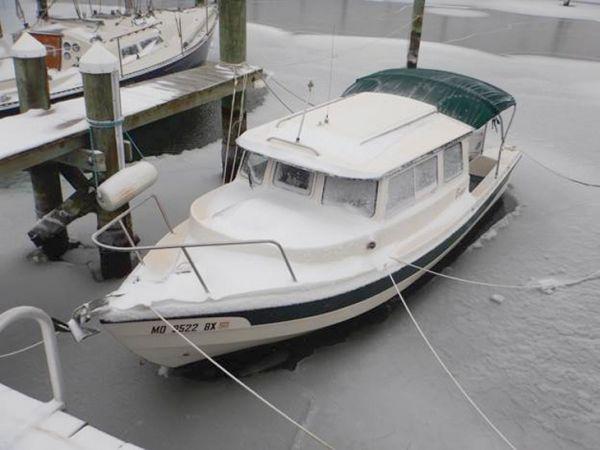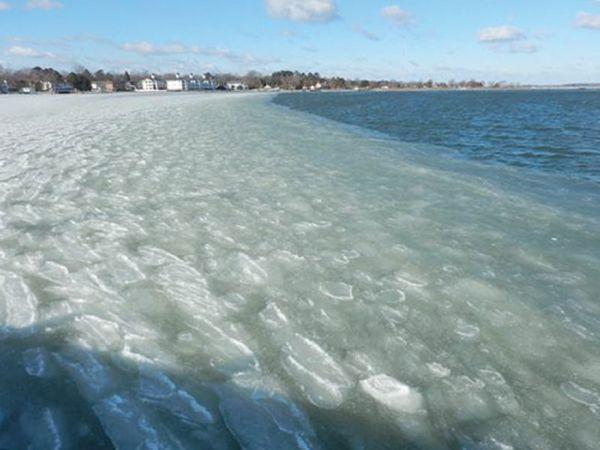While we have often taken our boats out for winter storage or taken them south to be able to use them through the cold season, there are years that we just keep the boat going as much as we can right at home. The best way to do this is to keep the boat in the water; if we pulled it in and out and stored it on its trailer, we would likely not use the boat nearly as much. We would also have to do more winterization on the engine each time.

With diesel inboards, the engine must be winterized after each use—a real pain to do and thus fewer times that we would be willing to go through all that work. With a modern outboard, you can get by with very little effort and be out on the water on a whim. But why keep your boat running through winter? For us it is to get full utility out of her, to have a little adventure, and to just experience something unique.
We have sought advice from a lot of experienced folks on keeping an outboard free from freeze-damage, and the most prevalent was to just keep the engine in the down position; a lot of fishermen do just that and have no problems. After an outboard is shut down, the water drains out by itself to where the waterline of the engine is. If the motor were to be tilted up, rain or melting snow could collect in the lower unit and cause damage when it froze. Parts of the water in this area of the engine will freeze at some point if the engine is down, but it will not be much and it will have the same ice on the outside and thus the pressures will be more equalized.
Gales, chafe, and docklines
The real concerns with winter in-water storage are those of gales, chafe, and docklines. Winter weather is apt to be stormy, and this means that the boat is going to be bouncing around a lot more than it would in summer. Once ice has formed around the boat, the docklines might need adjustment to keep them working properly. In water, the boat is free to move about in the slip, and the lines will adapt. When the boat is frozen in one place and some of the docklines are frozen to the ice, the boat may well get herself into trouble when the tide changes.
Once we commit to a floating winter, we have to recognize that the ramps will likely be the first places to freeze, and we will not be able to pull the boat until they are free again—too little, too late if the boat gets into trouble. We keep our boat a short walk from our house, so we can (and do) check on her every day. If we had to leave her to her own devices for weeks at a time, we probably wouldn’t leave her in for the winter. There are all sorts of trouble that a boat can get into in the winters: The bilge pump may freeze, the cockpit may fill with snow, or the boat may get top-heavy with frozen spray that can build quite rapidly in a stiff nor’easter.
This winter has been a test of how well we have prepared for the cold and gales. We were able to keep the boat going until just before Christmas, with a total number of days run just over 60 for the year. Our last little day-cruise was marked by running into ice in Warwick River and having it build up into a beard on the bow of the boat from flying and freezing spray. Although we could probably push the boat through thin ice, the effect that this would have on the bottom paint would not be good—and the boat makes a lot of unhappy noises in ice. Having an enclosed cabin to run the boat from is a necessity for winter operation, and the heating unit that our boat has to warm the interior is a big plus. Just being out of the wind and wet makes the most difference though.
Locked in ice
Sometimes the docks will be covered with frozen spray, or the wind will be blowing so hard that it is hazardous to venture out to the boat. These are the times during which your preparations come into play; if you have taken proper precautions, the boat will fare just fine. One good thing about being frozen in is that the ice will stop seas from building up, and the boat will lie still and happy through the worst winter storms. It is when the boat is in open water that she can get into trouble. Being locked in ice is not generally bad for the boat; the ice will not crush the boat and as long as you have taken everything that could freeze off, there is very little that can be damaged by cold and ice.

Just after our pre-Christmas run, the temperatures dropped dramatically, and the river proper started to ice over. Within a week or so, the entire river was iced in. There were about six inches of ice around our boat. The bilge pump sump was frozen solid, and I chipped it out gently to keep it free for the eventual thaw. There were days in which we could not get aboard the boat, because it had frozen away from the finger pier, and the decks were too snowy to take a chance on jumping across the gap. The sailboat next to us grounded out on a very low tide and snapped her bow line when the weight of the boat bore on that line as the boat lay over on her side: proof that boats should not be left to their own devices.
Two weeks later, the temperatures were in the 60s, and the ice was mostly gone. We still could not go out because there was a lot of loose ice in the river and the far shore was still iced over. The next day, the temperatures fell, and the winds blew the ice back in. Perhaps in a week or so, we will be able to get out on the water again. This means a lot to us. Being unable to get out on the water for a month is not bad—it leaves us with nearly an 11-month season, which is very acceptable. So long as we prepare well and keep an eye on her, we can get through the winter fine. As soon as the ice is out, we will be out on short cruises and enjoying the solitude of winter on the Bay.
by Rich Klepfer